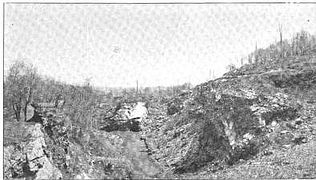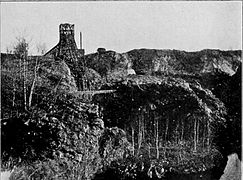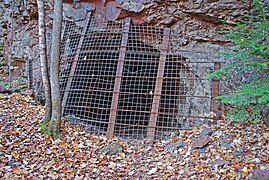Jackson Mine
Jackson Mine | |
 North Jackson Pit No. 1, 2010 | |
| Nearest city | Negaunee, Michigan |
|---|---|
| Coordinates | 46°29′55″N 87°37′22″W / 46.49861°N 87.62278°W |
| Area | 1 acre (0.40 ha) |
| Built | 1848 |
| NRHP reference No. | 71000414[1] |
| Significant dates | |
| Added to NRHP | September 03, 1971 |
| Designated MSHS | February 18, 1956[2] |
The Jackson Mine is an
Origin (1844–1847)


In 1844, government surveyor
In June 1845, businessmen organized the Jackson Mining Company in
In 1846, the company sent an expedition to the site to further explore the area and obtain more ore to test.[5][6] Forging the ore proved a success, and in the winter of 1846–1847, the Jackson Mining Company gathered equipment at the mine.[5] In 1847, the company organized men and machinery and began taking ore out of the mine.[2] It began constructing the Carp River Forge, which was finished the next year.[7] The first pieces of ore from the mine were forged at the Carp River and sold to construct a steamer.[5]
Rise of the Jackson Iron Company (1848–1870s)
In 1848, the Jackson Mining Company was re-incorporated with Fairchild Farrand as president; Berry and Everett and most of the rest of the original investors lost control of the company.[5] In 1849, the company got a new president, Ezra Jones, and a new name: the Jackson Iron Company.[5] In 1850, after numerous problems, the company gave up operation of their forge on the Carp River and leased the forge out.[5] The company was in a precarious financial position, and ceased work for a time on both their forge and mining operations.[5] However, production at the mine soon resumed, although company operations at the forge did not. Jackson began utilising the Marquette forge; however, they did ship some iron ore directly: the first shipment of five tons went to New Castle, Pennsylvania.[5] The purity of this ore shipment attracted attention, and General Joel B. Curtis, president of the Sharon Iron Company of Sharon, Pennsylvania, travelled to Michigan to inspect the mine.[5] Liking what he saw, he purchased a controlling interest in the Jackson Iron Company, and for some years the Jackson location was known as the "Sharon."[5]
With Curtis's guidance, the company began shipping more ore; in 1852, 70 tons were shipped to Sharon Iron.
However, the Jackson Mine was indifferently run, with frequent changes in management, and for some years a "record of disappointments and financial embarrassment."[5] In 1861, the management stabilized, and with the greater demand for iron during the Civil War, the Jackson Iron Company declared its first dividend in 1862.[5] The Jackson Mine ramped up its production, peaking in the late 1860s and early 1870s, with 1871 the year of maximum production.[2][10] The company established an iron furnace at Fayette in 1867,[5] and by 1875 had produced over 1.5 million tons of iron ore.[5]
- Mine Images, c. 1900
-
Original Jackson Mine pit, photographed c. 1900
-
Stump where Marji-Gesick showed Philo Everett evidence of iron ore
-
Jackson Mine, photographed 1912
-
Jackson mine c. 1915. Note miners standing in center right.
Decline and closure (1870s–present)
After the 1870s, ore prices declined.
By the time it closed, the Jackson Mine contained several working pits, as well as trial shafts, a forge, cross-cuts and drifts;[2] some of the underground workings were close to the surface. In the 1950s, the Jackson Mine and portions of the surrounding town of Negaunee were closed due to fears of collapse from undermining.[11] In recognition of the historical significance of the Jackson as the area's first iron mine, the site was designated as a Michigan State Historic Site in 1956 and placed on the National Register of Historic Places in 1971.[2]
The mine and area around it were acquired by the city of Negaunee in 2003 and the danger from undermining re-evaluated.[11] In 2006, much of "West Old Town Negaunee" and areas around the mine itself were re-opened to the public. The city developed a trail system through the area.[11][14] The overgrown ruins of the early Jackson Mine pit mines can be seen from the trail system.[2][11]
- Mine Images
-
Drift opening near North Jackson Pit No. 1, 2010
-
Cover over drift near North Jackson Pit No. 1, 2010
-
Abandoned foundation and machinery, 2010
Jackson Park
South of the Jackson Mine site is Jackson Park. This recreational area is 5 acres (2.0 ha), located next to Business M-28 (County Road), southwest of downtown Negaunee. It has a pair of tennis courts and two pairs of horseshoe courts. Before mining ended, it was 11.8 acres (4.8 ha)[15] and contained campsites.
See also
References
- ^ a b "National Register Information System". National Register of Historic Places. National Park Service. March 13, 2009. Retrieved November 20, 2010.
- ^ a b c d e f g h i j k l m n "Jackson Mine". Historic Sites Online. Michigan State Housing Development Authority. Archived from the original on May 24, 2012. Retrieved November 20, 2010.
- ^ Hannah, Tom A. (1903). Mines and Statistics (Report). Iron Mountain, MI: Michigan Department of Mineral Statistics. pp. 65–69.
- ^ Lake Superior Mining Institute (1898). Proceedings of the Lake Superior Mining Institute. Vol. 4. Lake Superior Mining Institute. pp. 90–91.
- ^ OCLC 6750767.
- ^ ISBN 0-8028-7055-4.
- ^ OCLC 7963374.
- ISBN 0-910845-31-X.
- ^ OCLC 1757295.
- ^ a b c Russell, James (1900). Mines and Statistics (Report). Marquette, MI: Michigan Department of Mineral Statistics. pp. 39–40.
- ^ ISBN 978-0-7360-7507-7.
- ^ OCLC 1025093.
- OCLC 7824071.
- OCLC 191062221. Archived from the originalon 2011-07-14. Retrieved 2010-12-02.
- ^ City of Negaunee (n.d.). City of Negaunee Five-Year Recreation Plan (PDF). City of Negaunee. Retrieved July 15, 2015.
External links
- Jackson Mine/West old Town trail map from the City of Negaunee




![Monument erected 1904 by the Jackson Iron Company at the site of the discovery of ore after destruction of the stump. The monument is now located on US 41.[11]](http://upload.wikimedia.org/wikipedia/commons/thumb/d/d1/JacksonMineMonument.jpg/225px-JacksonMineMonument.jpg)




